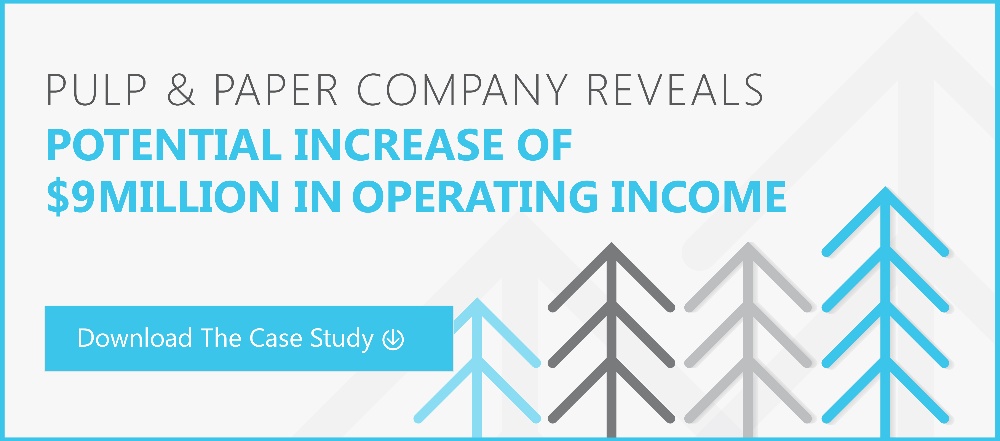Now that you’ve given paper your attention, pretend you are given the task to create a holistic model for the entire, worldwide pulp-and-paper industry. Not just for a company, product family, or even a specific geographical region, but for the complete industry. That was my assignment in the spring of 2003.
The Challenge
The pulp-and-paper industry has:
- More than 2,400 paper mills (any mill producing more than 50 tons per day) in over 80 countries on every continent except Antarctica, and each mill has different equipment, recipes, yields, rates, labor costs, etc.
- Thousands of products with varying complexity, each product requiring a different mixture of labor, fiber, chemicals, minerals, materials, fuel & steam, power, and water.
- Dozens of different units of measure and currencies.
From a global trade standpoint the pulp-and-paper industry still ranks as one of the most diverse and important. It’s not so much a single industry as it is a collection of related industries. Larger companies continually aim for economies-of-scale, while smaller companies focus on niche but sustainable businesses. Vertically integrated companies own their fiber supply to manufacturer pulp and paper (in large rolls); while other companies purchase pulp to manufacture paper products.
My challenge was to build a comprehensive, holistic model that would satisfy our partner, Fisher International. Using Fisher’s industry-leading database as input, the model had to be flexible and detailed enough to optimize for all products manufactured at all mills. The goal was to extract the model’s detailed unit costing solution values for use in a new software product we were developing called Fisher Logic Cost Benchmarking.
The Approach
Traditionally, in all but the simplest problems, optimization is largely a computer programming exercise. It requires a combination of mathematical intelligence combined with computer science knowledge, and demands users think in terms of variables and constraints, coefficients and right-hand-sides. Modeling an entire industry, like the paper industry, is essentially creating over 2,000 unique “models”, all overlapping to some extent. Unless you have a small army of developers with considerable financial resources and experience, modeling any industry at this level requires a “non-traditional” approach.
In his upcoming book Newtonian Economics, Dr. Robert Whitehair describes a modeling process by creating an Enterprise Diagram, which is similar to a “free-body diagram” taught in many beginning physics and engineering classes. Dr. Whitehair states,
“Free-body diagrams show the relative magnitude and direction of all the physical forces acting upon an object in a given context. The arrows in a free-body diagram reflect the magnitude and direction of the forces acting on the object. Each force arrow in the diagram is labeled to indicate the exact type of force.
Enterprise diagrams show the flow of all the process activities associated with an enterprise in a given context. In effect, an enterprise diagram shows the financial and operational forces acting on an enterprise in a given context.”
When I read these words for the first time, this made perfect sense. Dr. Whitehair’s approach doesn’t deny the importance of the math, because of course it is; rather, he argues, how can one create a holistic model without visually “seeing” the problem being modeled?
As I’ve discovered in my 20-year career, it’s very difficult. Imagine using Netflix for a couple of years and then considering going back to renting movies from a store again. Although you could do it, why would you? Optimization modeling has a similar progression: once you can visually model any business problem – displaying all the various flows and how they are interconnected – why would you want to write code again if you didn’t have to?
The Solution: A Full Pulp and Paper Industry Model
Even back in 2003, I had the advantage of using River Logic’s Enterprise Optimizer® (EO) software, a 5th generation “knowledge capture” program, to create the paper industry model. Without a need to write code or scribble equations on a whiteboard, I was able to focus my energy on “drawing” a complete enterprise diagram for the industry. By working with Fisher’s industry experts, it was a straightforward process of translating their knowledge and requirements into the visible process flows necessary to model the problem accurately. The final, comprehensive design looked like a “supermill”, a fully integrated plant that could make any product anywhere in the world, and was easily recognizable and understandable by anyone in the pulp-and-paper industry.
An Update
Working with our partner Fisher International (www.fisheri.com), the leading provider of pulp-and-paper industry content, we spent the remainder of 2003 and into 2004 refining and fine tuning the Fisher Logic solution. Today, the EO model is still used to generate the detailed unit costing data, but Fisher now includes the cost data within their FisherSolve product.







